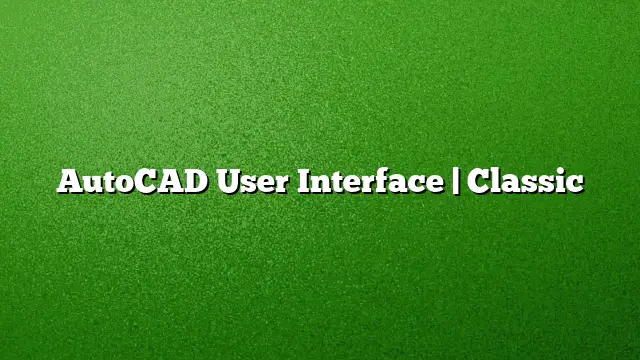Understanding the AutoCAD User Interface: Classic Mode Explained
The AutoCAD environment is highly customizable, catering to different user preferences and workflows. One common request from users is for the return of the Classic workspace, primarily due to concerns about the ribbon interface. Many users feel that the ribbon’s size can hinder productivity, while others simply prefer a simpler, more traditional interface style. This article aims to guide you through creating a Classic-style workspace in AutoCAD 2025, enabling a more streamlined work environment.
Setting Up the Classic Workspace
If the modern ribbon doesn’t suit your needs, you can restore a minimalist interface that resembles the classic workspace. Follow these steps to achieve that:
- Type RIBBONCLOSE in the command line to hide the ribbon entirely.
- Next, activate the menu bar by entering MENUBAR 1.
- From the menu bar, navigate to Tools then select Toolbars and choose AutoCAD, followed by Layers.
- Repeat this step to add the Properties toolbar, or any additional toolbars you wish to include.
- Position the toolbars at the top of the drawing area for easier access.
- Revert to a minimal menu bar layout by typing MENUBAR 0.
- To save your customized workspace, click the Workspace button and choose Save Current As. Name it something recognizable, like “Minimal” or “Classic Style.”
Your newly created workspace can now be easily switched between different configurations, allowing you to tailor your interface to various project requirements.
Removing Unused Interface Elements
An uncluttered user interface can significantly enhance focus and efficiency. If you notice components that are rarely used, consider disabling them. Here’s how:
- If you find the Viewcube unnecessary, type NAVVCUBEDISPLAY 0 to disable it.
- For the navigation bar below the Viewcube, similarly enter NAVBARDISPLAY 0.
- Remove any inactive buttons from the status bar by clicking the Customization menu located in the lower-right corner and disabling those you don’t need.
If you prefer to add more functionality to the Quick Access toolbar, click on its drop-down menu and select additional tools you frequently use.
Accessing Advanced Customization Options
AutoCAD 2025 offers an array of advanced customization options to optimize your user interface further. To explore additional elements, proceed as follows:
- Open the OPTIONS dialog box and navigate to the Display tab.
- Here, you will find options to modify various buttons on toolbars and ribbon tabs to suit your workflow better.
- Feel free to adjust these settings according to your preferences, creating a workspace that feels intuitive and personal.
Additional Resources for Mastering AutoCAD’s UI
Frequently Asked Questions
- Can I revert back to the default ribbon interface after switching to the Classic workspace?
Yes, you can easily switch back to the default ribbon by closing your customized workspace and activating the ribbon using the command RIBBON. - Is it possible to save multiple workspaces in AutoCAD 2025?
Absolutely! You can create and save multiple custom workspaces to switch between various setups depending on your project needs. - What if I want to customize my toolbars further?
Toolbars can be customized through the Customize window, allowing you to add, remove, or rearrange your tools to create a layout that works best for you.

